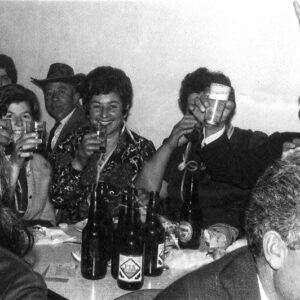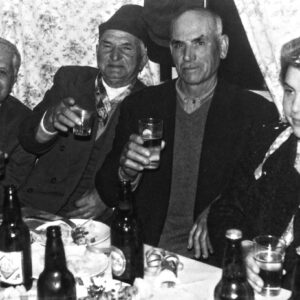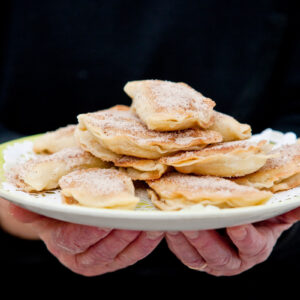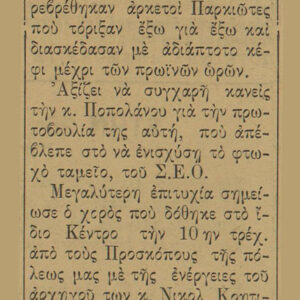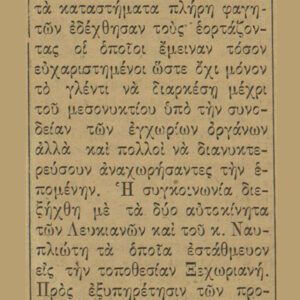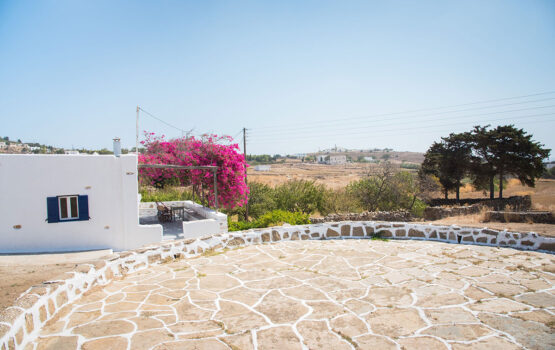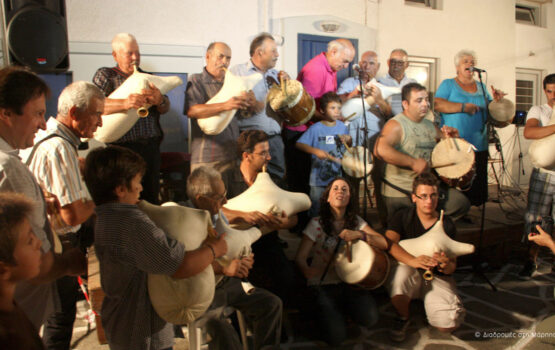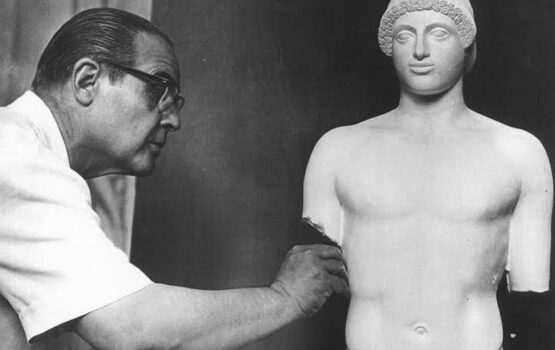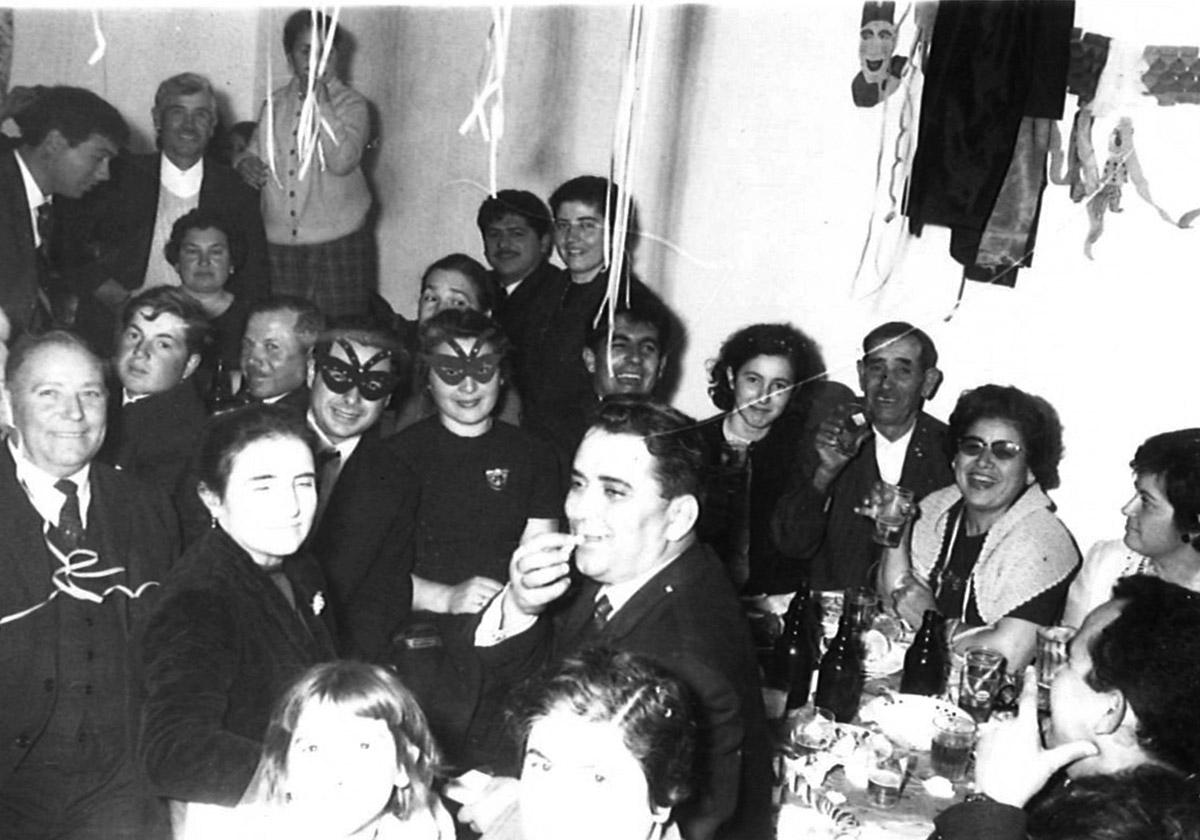
Carnival in Marpissa
Tis carnival time already, Easter’s on its way (43).
Zacharias Stellas. Paros, unshapely paintings: Tales, Fairytales and other elements of folklore and language
In Marpissa, carnival was celebrated “in mirth and partying” (Stellas, 2005, p. 44). From the day opening the pre-lenten season, i.e. the Sunday of the Publican and the Pharisee and continuing through the Meat-Fare Sundy, at night, when people in costumes visited one house after the other, sang, jested and had fun.
“In the evening at about 7, when it was dark, those who enjoyed dressing up would go out and start jesting and talking to you to take you by surprise” (Flora Anousaki).
Their varied costumes were improvised, made mainly from clothes, accessories and objects found in any household. They made sure their faces were covered and, hidden behind the shield of anonymity, they expressed themselves freely and jested with other locals, in line with the Carnival spirit.
The disguise aimed to hide the identity of the disguised.
“Argyro, my sister, was so good at disguises she always took everybody by surprise. Once she wore father’s old clothes, went out from the back door, and appeared at our house door, in disguise, with a friend of hers. She came into the house, talked with our parents in a changed voice and even they didn’t recognise her. Later, when she returned home, she heard them talking of a strange reveller they could not identify” (Katina Alipranti).
“There was this one time when I tried to remove someone’s mask, like that, – I thought it was my disguised cousin – and they jumped on me with a stick, I got pounded… Never ever even consider of messing with a disguised reveller” (Spyros Tsigonias).
On the last pre-lenten Sunday, the party would spread across the village, with disguised revellers going from house to house and from rooftop to rooftop before ending up in the squares and tavernas. People opened their houses to welcome revellers and offered them
“raviolia or rafiolia” (fried mini pies with mizithra cheese and honey or sugar and cinnamon), a typical treat of the season, the “sweet dessert” as cited by Zacharias Stellas. The “Apokreoi”, i.e. the revellers, would start singing improvised rhymes and jesting with their host and danced the Ageranos which was a favourite during that season:
“My sweet tongue start singing all sorts of song
so that my good friends can party all night long…”
For the Ageranos, dancers hold each other’s shoulders or even hug, forming a circle and repeat the rhymes dancing. This dance dates back to antiquity. According to Plutarch, it originates from Delos, where it was danced by Theseus and other young people around the altar of horns, on his way back from Crete after he killed the Minotaur. The Ageranos allowed people in love to express their feelings towards their special someone covertly, using rhymes.
“Meat-fare Sunday is gone, Cheese-fare Sunday is coming, here comes Lent with its seven weeks of fasting”.
They also danced to other kalamatiano songs, such as “Militsa pou se sto gremno” or “Mia kori roda mazeve” and of course “Pos to trivoun to piperi”, the well-known carnival song that is popular in many parts of Greece.
During the Carnival, there is always a satirical aspect to everything. As in Greece, so in Paros, it offers the best opportunity for fun and celebration that elevated the mood of the residents. So, in Marpissa during this period, we can listen to songs that present a different, more comedic concept of love:
“… An old woman with one tooth was looking for a man
Despite her old age her heart was longing for a man
One day as she was cooking leeks with butter
She heard that she should go and get married
On the road she met an old man and she said
I will hug the old man or I will bring the world upside down… “
The spontaneity and authenticity of the local people would not prevent them from revealing further details of the everyday life of a couple, satirising the difficulties of human relationships or any”incompatibility” between the two sexes:
“In hard times I wished to get married
and they gave a woman who ate for 5 or 10
my dear husband I want a hat with a veil
my husband I want heels with a bow”
On Clean Monday they would fly kites at Antiligadi and Piso Livadi. The main lent fasting dishes were olives, halva, taramosalata, lagana bread and seafood.
Athanasios Katselidis of the local newspaper “Foni tis Parou” (issue 61, April 1951) reported:
On Clean Monday, more than 500 people from Parikia of Lefkes and the surrounding cottages travelled to Piso Livadi to celebrate the first day of Lent. The coffee-houses and tavernas welcomed them all, who were so pleased they kept the party strong until midnight, accompanied by local musicians, while some even spent the night there before returning home on the following day.
Sources
Archives of the Association “Routes in Marpissa”.
Katselidis, A. (1951) “Τα κούλουμα στο Π. Λειβάδι” (First Day of Lent at P. Livadi), newspaper I Foni tis Parou, issue 61, April, p. 2
Stellas, Z. (2005) ΠάΡΟΣ, ζουγραφιές ατσούμπαλες, ΜύΘΙΑ ΠΑΡΑΜύΘΙΑ. (Paros, unshapely paintings: Tales, Fairytales) Athens: n.p.
Fragkouli, D. Δ. (2009) Ρίζες Ελλήνων Ανθρωπογεωγραφία της Ελλάδας, Νησιώτες: Νότιο Αιγαίο (Roots of Greeks- Human Geography of Greece, Islanders: the South Aegean). Athens: Pigasos Ekdotiki S.A.
Carnival at Naoussa of Paros, excerpt from the show of ERT-1 “…σε όλη την Ελλάδα” – “ΚΑΡΝΑΒΑΛΙΑ ΣΤΟ ΑΙΓΑΙΟ” (…around Greece – Carnival in the Aegean) (2011) ERT archives. Available at: www.youtube.com
Special thanks to Katina Alipranti, Flora Anousaki, Spyros Tsigonias for the information and their valuable assistance.


